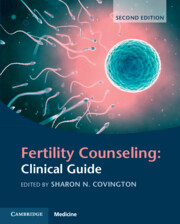Book contents
- Fertility Counseling: Clinical Guide
- Fertility Counseling: Clinical Guide
- Copyright page
- Dedication
- Contents
- Preface
- Contributors
- I Introduction
- II Therapeutic Approaches
- III Third Party Reproduction: Assessment and Preparation
- Chapter 9 Counseling Recipients of Nonidentified Donor Gametes
- Chapter 10 Counseling Nonidentified Gamete Donors
- Chapter 11 Counseling Embryo Donors and Recipients
- Chapter 12 Special Considerations in Gestational Surrogacy Assessments and Arrangements
- Chapter 13 DNA and the End of Anonymity: Disclosure, Donor-Linkage and Fertility Counseling
- Chapter 14 Family Life after Donor Conception
- IV Addressing the Needs of Diverse Populations
- V Special Topics in Fertility Counseling
- VI Practice Issues
- The International Glossary on Infertility and Fertility Care, 2017
- Index
- References
Chapter 13 - DNA and the End of Anonymity: Disclosure, Donor-Linkage and Fertility Counseling
from III - Third Party Reproduction: Assessment and Preparation
Published online by Cambridge University Press: 24 November 2022
- Fertility Counseling: Clinical Guide
- Fertility Counseling: Clinical Guide
- Copyright page
- Dedication
- Contents
- Preface
- Contributors
- I Introduction
- II Therapeutic Approaches
- III Third Party Reproduction: Assessment and Preparation
- Chapter 9 Counseling Recipients of Nonidentified Donor Gametes
- Chapter 10 Counseling Nonidentified Gamete Donors
- Chapter 11 Counseling Embryo Donors and Recipients
- Chapter 12 Special Considerations in Gestational Surrogacy Assessments and Arrangements
- Chapter 13 DNA and the End of Anonymity: Disclosure, Donor-Linkage and Fertility Counseling
- Chapter 14 Family Life after Donor Conception
- IV Addressing the Needs of Diverse Populations
- V Special Topics in Fertility Counseling
- VI Practice Issues
- The International Glossary on Infertility and Fertility Care, 2017
- Index
- References
Summary
Direct-to-consumer (DTC) DNA testing has had a major impact on people affected by donor conception, including donor-conceived people, their parents, and donors. It has enabled people to discover their conception status and to identify the donor. Donors who were assured of anonymity and their extended families are being contacted by their donor offspring and recipient parents. Consequently, it is now impossible to assure donors they will be anonymous, and parents can no longer consider that nondisclosure of donor treatment to their children is a viable option. Fertility counselors need to prepare their clients for the implications of DTC DNA testing, be fully informed of the repercussions faced by donor-conceived adults, especially those finding out their conception status past childhood, and also to have donor-linking skills as part of their counseling tool kit.
Keywords
- Type
- Chapter
- Information
- Fertility Counseling: Clinical Guide , pp. 134 - 143Publisher: Cambridge University PressPrint publication year: 2022

